Words spill out of Cloud Gate Dance Theatre (雲門舞集) artistic director Lin Hwai-min (林懷民) in torrents of energy, often faster than his dancers’ movements, but just as carefully calibrated. It does not matter if he is speaking Chinese or English, he rushes along, sometimes spinning off on a tangent, but always returning to his core ideas.
Words, especially in their written form, have been as important to Lin as dancing, even from childhood. Long before he founded the nation’s first professional modern dance troupe, he had made his name as a writer, and an author’s storytelling craft has often informed his choreography.
He had his first story published in a newspaper when he was 14, and his 1969 novel Cicada was a best-seller; ancient Chinese tales inspired his early dance works and his Cursive (行草) trilogy was inspired by Chinese calligraphy.
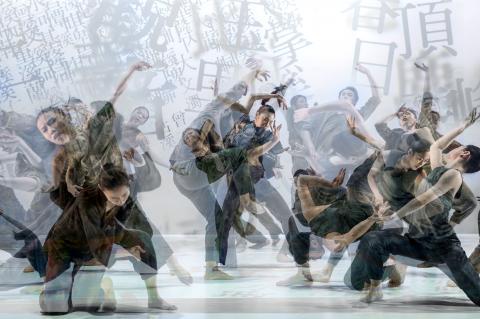
Photo Courtesy of Liu Chen-hsiang
Words, in the shape of Chinese typescript, are the basis upon which he built his newest work, Formosa (關於島嶼): Characters form the backdrop and landscape of his story about the land, history and people of Taiwan, while a recitation — a selection of poems and excerpts of essays about the land and the people — by poet, calligrapher and painter Chiang Hsun (蔣勳) is part of the soundscape.
Thirty-nine years ago with Legacy (渡海), which many experts cite as the watershed production that shaped Taiwan’s contemporary dance scene, Lin told the story of the early Han Chinese settlers who crossed the “Black Water” — the Taiwan Strait — hundreds of years ago in search of a better life than the ones wracked by famine and wars they were leaving behind.
Formosa tells of those settlers, but the main focus is the island’s Aborigines, as well as the foreign soldiers and traders and others who came after them, all combining to form the multi-ethnic, multicultural island we know today. It is also a story of island shaped by tragedy, some man-made in the form of conquests and political ideology, others wrought by Mother Nature through typhoons and earthquakes.
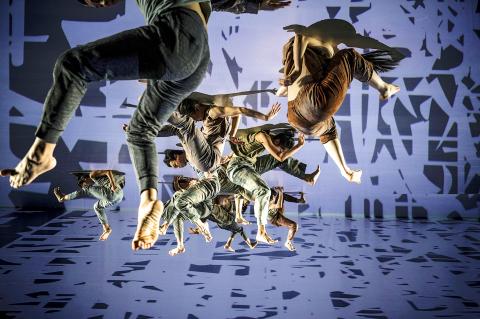
Photo Courtesy of Liu Chen-hsiang
However, Formosa is far more abstract than Legacy, the storytelling not so linear.
In a telephone interview with Lin before he took his company on a six-city tour of China last month, Lin said that with Formosa he was not trying to talk about Taiwan as a news report, editorial or philosophy.
“Formosa is just a metaphor for an island haunted by earthquakes, typhoons and international fights… the material is grown from the land, but it’s not about land, it’s about everywhere,” Lin said.
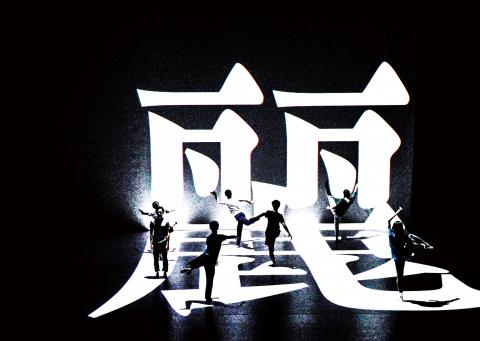
Photo Courtesy of Liu Chen-hsiang
“There is an epigram from the Diamond Sutra: All things contrived are like dream, illusion, bubble, shadow; and as dewdrop or lighting. They should be regarded as such,” Lin said. “I have had that in the back of my mind all my life.”
The show starts with whiteness and ends with emptiness, he said.
“The first characters are projected as a subtitle for Mr Chiang’s recitation for a few minutes, then they go on their own way,” he said. “First the poem, the characters are seen afterwards,” he added.
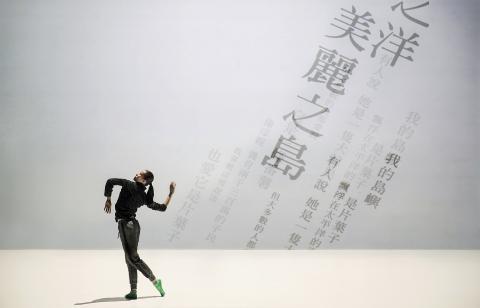
Photo Courtesy of Liu Chen-hsiang
Asked why he decided have Chinese characters play such a key role in the new work, given that he had explored Chinese calligraphy in his Cursive trilogy, he said it was because “words communicate … but they become blurred with the passage of time. Records of history could be erased, rewritten.”
Often the characters used in the projections are the names of animals, villages, rivers and places in Taiwan, “but they are mostly broken. Tam (淡) here, shui (水) over there,” he said, referring to a district of New Taipei City. “They are broken, painted for landscape … made abstract pictures to evoke memories of ancient writing.”
“The characters expand... into rivers of words, then become a landscape, they drop like rocks, like bombs on the floor, they become a monster, kill people,” he said using his usual rapid-fire delivery. “We did a wonderful ‘bang, bang, bang, bang onto floor.’”
Then from out of the darkness come stars, each one made of a character, he said.
“They are like glowing diamonds onto the dancers... Some stars are amplified, drift into space,” he said. “A lot of words gradually break. Wo ai ni (“I love you,” 我愛你) starts at center stage, then the heart fades away, love without a heart. It is like seeking wrecks of spaceships floating away.”
The projection design was done by Chou Tung-yen (周東彥) and Very Mainstream Studio, while Howell Chang Hao-jan (張皓然) did the videography.
For the score, Lin used percussive music by Paris-based Finnish composer Kaija Saariaho, Taiwanese musician Liang Chun-mei (粱春美) — who worked with Lin on "Cursive 3" (Wild Cursive, 狂草) — and Puyuma singer Sangpuy Katatepan Mavaliyw.
However, it is Sangpuy as his fans have never heard him; as even the musician had never heard himself. He becomes the voice of nature for the show.
Lin said Sangpuy agreed to work on the production only if several demands were met, including not singing Aboriginal songs or his own works.
“We dragged him, pushed him, finally locked him in the studio where he howled, screamed, murmured,” Lin said. “At end of three [recording] sessions of his voice, our music director patched it together,” he added, but almost deafened himself in the process.
Formosa, which the company has been billing as three years in the making, premieres on Nov. 24 at the National Theater as part of the National Theater Concert Hall’s Dancing in Autumn series, but only because Lin wanted to have the premiere in Taiwan.
The show was originally scheduled to premiere last year at the opening of the Taipei Performing Arts Center in Shilin District (士林), but when construction on the center was stopped temporarily, the company had to come up with Plan B, and that was this month at the National Theater since the show was coproduced with the NTCH.
Other coproducers include the National Kaohsiung Center for the Arts (another project that is years behind schedule), Sadler’s Wells in London, the Theatre de la Ville in Paris and the Carolina Performing Arts at the University of North Carolina at Chapel Hill, meaning that the show has already been booked for tours to the US, the UK and France starting early next year.
Performances are also set for Germany, Portugal, Russia that will keep the company busy touring the show next year and into 2019.
But first there is Taiwan itself and Cloud Gate’s loyal fanbase. After 10 performances at the National Theater, Cloud Gate will take the show to Taichung, Kaohsiung and Lin’s hometown of Chiayi.

Most heroes are remembered for the battles they fought. Taiwan’s Black Bat Squadron is remembered for flying into Chinese airspace 838 times between 1953 and 1967, and for the 148 men whose sacrifice bought the intelligence that kept Taiwan secure. Two-thirds of the squadron died carrying out missions most people wouldn’t learn about for another 40 years. The squadron lost 15 aircraft and 148 crew members over those 14 years, making it the deadliest unit in Taiwan’s military history by casualty rate. They flew at night, often at low altitudes, straight into some of the most heavily defended airspace in Asia.

This month the government ordered a one-year block of Xiaohongshu (小紅書) or Rednote, a Chinese social media platform with more than 3 million users in Taiwan. The government pointed to widespread fraud activity on the platform, along with cybersecurity failures. Officials said that they had reached out to the company and asked it to change. However, they received no response. The pro-China parties, the Chinese Nationalist Party (KMT) and Taiwan People’s Party (TPP), immediately swung into action, denouncing the ban as an attack on free speech. This “free speech” claim was then echoed by the People’s Republic of China (PRC),
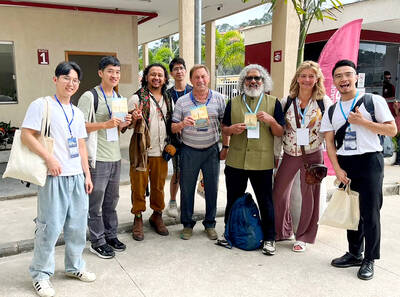
Many people in Taiwan first learned about universal basic income (UBI) — the idea that the government should provide regular, no-strings-attached payments to each citizen — in 2019. While seeking the Democratic nomination for the 2020 US presidential election, Andrew Yang, a politician of Taiwanese descent, said that, if elected, he’d institute a UBI of US$1,000 per month to “get the economic boot off of people’s throats, allowing them to lift their heads up, breathe, and get excited for the future.” His campaign petered out, but the concept of UBI hasn’t gone away. Throughout the industrialized world, there are fears that
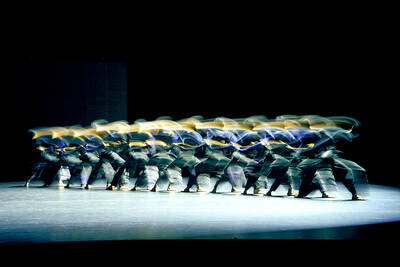
Like much in the world today, theater has experienced major disruptions over the six years since COVID-19. The pandemic, the war in Ukraine and social media have created a new normal of geopolitical and information uncertainty, and the performing arts are not immune to these effects. “Ten years ago people wanted to come to the theater to engage with important issues, but now the Internet allows them to engage with those issues powerfully and immediately,” said Faith Tan, programming director of the Esplanade in Singapore, speaking last week in Japan. “One reaction to unpredictability has been a renewed emphasis on